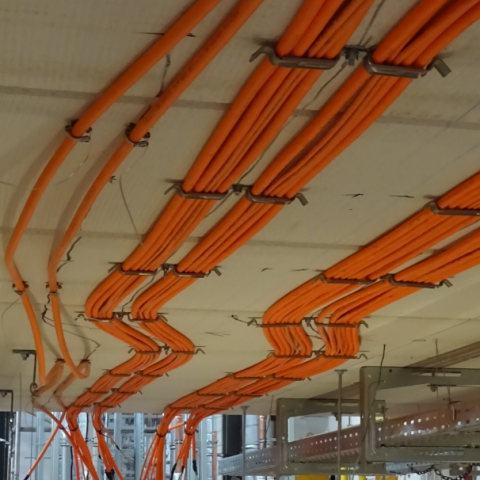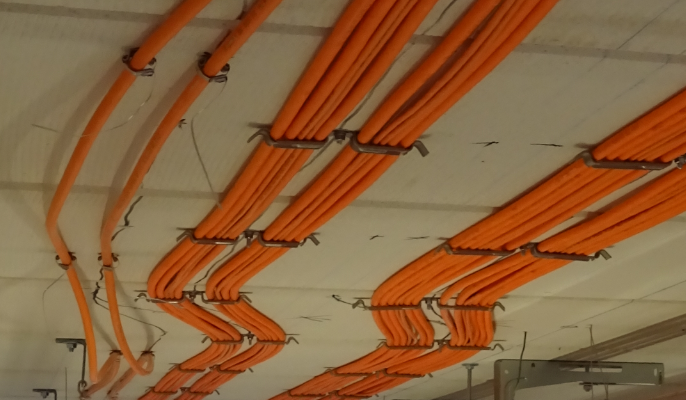Across Europe, commercial building regulations dictate that electrical cable systems including fastener components must maintain functional integrity in the event of a fire, thus ensuring exit signs, alarms and other emergency systems will continue to operate in the short term. These requirements are largely based on the German DIN 4102-12 standard that has influenced fire safety rules for construction in European countries for years. Often we are reminded of the immense importance of fire-rated products, especially when tragedies like the Grenfell Tower fire in London or the burning of the Notre Dame de Paris cathedral occur.
About DIN 4102-12?
Protecting structures—and more importantly, the people inside them—starts by understanding DIN 4102-12, then ensuring you have compliant products in place to provide safe conditions. The intent of the standard is to determine the circuit and mechanical reliability of building components for a designated time period during a fire. Per the standard, a fire chamber is used to test cabling and related supports wherein a voltage of 400V AC is applied to the cabling and flame temperatures exceed 1000ºC during the test. Depending on results, products are assigned an E30, E60 or E90 rating, with the numbers reflecting the product’s fire life in minutes.
Examples of systems that must achieve an E30 rating include fire exit signs, elevators and fire alarms as well as smoke ventilation equipment. And while there are no E60 rating requirements in Germany, other countries, such as France, may require this higher-level designation for emergency light supports. An E90 rating, meanwhile, is required for automatic fire extinguishing systems and water pressure equipment, mechanical smoke extractors in some stairways, elevators for hospital beds and for designated fire access areas.
What fire-rated components are required?
There are various components of electrical systems that must be tested to establish the structural integrity necessary to award a functional integrity rating under DIN 4102-12.
- Structural elements: Products such as I-beams that are tested and approved for a specific load. These are architectural products that are part of the building structure.
- Fixings/Anchors: Load-rated products such as nVent CADDY drop-in anchors, M10 threaded rods or M10 hex nuts.
- Supports: Supports, such as nVent CADDY J-Hooks, nVent CADDY Universal Tray Support or the nVent CADDY Metal Pressure Clip, that run beneath cable bundles or cable trays to maintain rigidity and weight dispersion.
- Cables (and tray, if used): Electrical cables and trays that hold them together/aloft.
Note that all components must be tested together for a system to be fire-rated—this includes supports, cables and tray, if applicable. Generally, these system components must be used as described in the certificates, and the rating is as stated even if components have higher ratings from previous tests. This includes structural elements as well: Using an E30 fire-rated clamp on a non-fire-rated beam, for instance, is not enough for an E30 system rating.
To help installers meet safety requirements, nVent CADDY offers a complete line of fire-rated solutions, from supports, clips and hooks to concrete anchors. Examples include:
- nVent CADDY Universal Tray Support: Made of galvanized steel, this accommodates various cable tray hanging methods.
- nVent CADDY Metal Pressure Clips: M-shaped, flexible clips for smaller runs of cable offer superior corrosion resistance.
- nVent CADDY CAT HP J-Hook System: A system that comes in various sizes, suitable to support power, data, fiber optic and security cable.
- nVent CADDY Rod Lock Telescoping Strut Replacement: Extends and locks at desired length, allowing the user to simply push the prefabricated trapeze onto the threaded rods, thanks to the patented nVent CADDY Rod Lock technology.
- Cable Tie Fasteners and Cable Ties: Attached to nVent CADDY fasteners or screwed directly into walls or ceilings, these components secure low-voltage cables.
- Concrete Anchors: nVent CADDY offers a variety of fire-rated fixings suitable for fire integrity applications.
While DIN 4102-12 is related specifically to the functional integrity of electrical systems when exposed to fire, there are other fire standards you may need to reference that govern other aspects of combustion-related material performance, including frequently referenced documents:
- DIN 4102-1: Reaction to fire of components
- DIN 4102-2: Structural elements (walls, stairs, ceiling)
- BS EN 1363-1: Fire-resistance tests, general regulations
- BS 476-20: Structural elements
- EN 13501: Behavior toward fire when not on fire
- BS EN 61537: 2007: Resistance to fire (construction)
How can you get started?
As discussed, there are varying requirements for functional integrity of different applications of electrical systems in commercial buildings, with the country and application primarily dictating if you will need an E30, E60 or E90 fire rating. Be sure to know the difference when looking into local regulations—some decision-makers, for example, have made the mistake of investing heavily in achieving E90 ratings when an E30 rating would have sufficed.
If you are ever unsure about which products are appropriately fire-rated for your electrical cabling applications, don’t hesitate to ask your supplier, as they can likely point you in the right direction to promote the safety of building occupants in every situation. For more insight consult the nVent CADDY Fire Brochure or contact us here.


